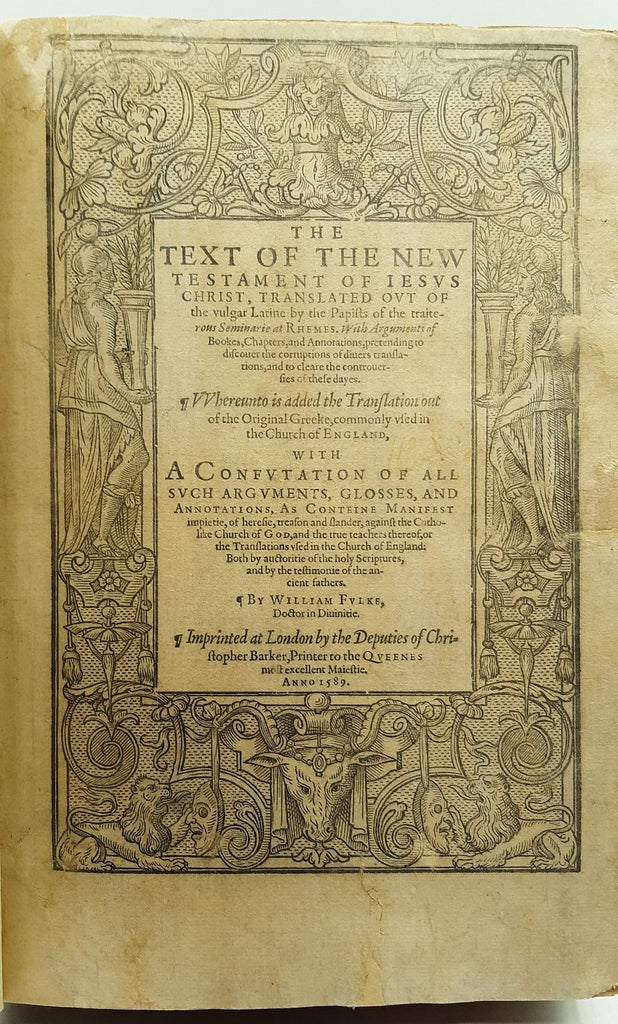The Text of the New Testament of Jesus Christ, translated out of the vulgar Latie by the Papists of the traiterous Seminarie at Rhemes.
HOLY BIBLE






London: Deputies of Christopher Barker. 1589.
First edition. Folio (274x185mm). ll. [23], 496, [5]. *⁴ A-Y⁶ 2A-2Y⁶ 3A-3Y⁶ 4A-4V⁶ 4X⁴. Text in parallel columns, 56 lines to the full column: Rheims New Testament printed in roman type on the left, the Bishops' version in italics on the right, both divided in verses, all arguments, marginal notes, and other annotations of the Rheims NT printed at the end, interspersed with the confutations, title within woodcut border, woodcut initials, head and tailpieces. In excellent condition throughout with only one small marginal repair to the foot of 4A2 (not affecting the text) and some slight foxing. Modern calf decorated in blind to covers and spine. brown morocco labels to spine lettered in gilt. Front pastedown has label of Brian E. Fortune.
A very good copy of the first edition of William Fulke's refutation of the arguments and accusations contained in the Rheims New Testament of 1582 (see previous item). Fulke was described by a contemporary as "that profound, ready and resolute doctor, the hammer of heretics, the champion of truth". He was fully committed to the idea that the Pope and the Church of Rome were the Antichrist and much of his work involves a point-by-point unpicking of Catholic theology both in writing and in public debate, most famously with Edmund Campion in the Tower of London. He was so concerned to counter Catholicism on its own terms that he inadvertently drew attention to theological arguments that would otherwise have remained obscure and unknown. This method of forensic disputation, with its unintended consequences, is evident in this Bible where the Rheims New Testament and the Bishops' version are printed "in full, side by side, with Fulke's commentary at the end of each chapter. This tandem printing secured for the former a publicity which it would not otherwise have obtained, and was indirectly responsible for the marked influence which Rheims exerted on the Bible of 1611". (Herbert).
First edition. Folio (274x185mm). ll. [23], 496, [5]. *⁴ A-Y⁶ 2A-2Y⁶ 3A-3Y⁶ 4A-4V⁶ 4X⁴. Text in parallel columns, 56 lines to the full column: Rheims New Testament printed in roman type on the left, the Bishops' version in italics on the right, both divided in verses, all arguments, marginal notes, and other annotations of the Rheims NT printed at the end, interspersed with the confutations, title within woodcut border, woodcut initials, head and tailpieces. In excellent condition throughout with only one small marginal repair to the foot of 4A2 (not affecting the text) and some slight foxing. Modern calf decorated in blind to covers and spine. brown morocco labels to spine lettered in gilt. Front pastedown has label of Brian E. Fortune.
A very good copy of the first edition of William Fulke's refutation of the arguments and accusations contained in the Rheims New Testament of 1582 (see previous item). Fulke was described by a contemporary as "that profound, ready and resolute doctor, the hammer of heretics, the champion of truth". He was fully committed to the idea that the Pope and the Church of Rome were the Antichrist and much of his work involves a point-by-point unpicking of Catholic theology both in writing and in public debate, most famously with Edmund Campion in the Tower of London. He was so concerned to counter Catholicism on its own terms that he inadvertently drew attention to theological arguments that would otherwise have remained obscure and unknown. This method of forensic disputation, with its unintended consequences, is evident in this Bible where the Rheims New Testament and the Bishops' version are printed "in full, side by side, with Fulke's commentary at the end of each chapter. This tandem printing secured for the former a publicity which it would not otherwise have obtained, and was indirectly responsible for the marked influence which Rheims exerted on the Bible of 1611". (Herbert).
